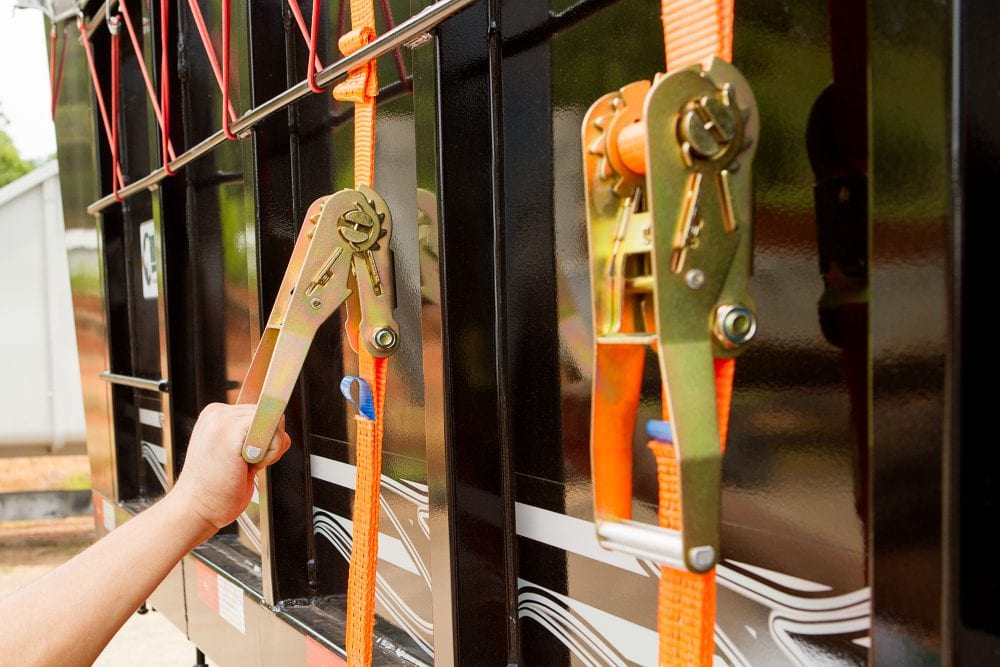No products in the cart.
Load Tie Down
More safety in the equipment and goods transportation
Proper load lashing can avoid many problems during the journey, such as goods loss, accidents and delays. The objective is to prevent the load from moving during transportation, especially in the case of evasive maneuvers, curves and braking.
In addition, some precautions must be observed to comply with the regulations requirements that regulate the load transportation, such as Contran 552 Resolution.
In this article, we will offer tips on how to properly lashing loads and have more safety when transporting goods and equipment.
1. Do not use ropes to tie down loads
Resolution 552 of the National Transit Council prohibits the use of ropes in the lashing and recommends the use of equipment such as ratchet straps, cable or steel chain. After all, ropes are less strong and can wear out over time and break during transportation. Therefore, they can only be used to tie the tarp.
Also, according to the standard, the strength of the straps, steel cables and chains must be at least twice the weight of the transported load. The resolution also prohibits that the load lashing is made directly on the bodywork wood, which often does not offer the necessary resistance to support the load weight.
In addition, other items such as nets, meshes, rails, blockers, spacers, protectors, and friction blankets can be used to reinforce security. However, these accessories can only be used externally when the transported items occupy the entire internal bodywork space.
2. Distribute well the load weight on the body
Good safety practices recommend that the load is secured to the vehicle and that this anchor can withstand certain forces, under normal conditions:
- Forward: 80% to 100% of the load weight;
- For the sides and rear: 50% of the weight;
- Upwards: 20% of the weight.
Generally speaking, we have two main methods that can be used to lashing loads more securely:
Vertical or friction lashing: The lashing equipment are used on the load by the compression force applied by the user through the tensioner. This creates a net downward force which, combined with the friction coefficient between the vehicle floor and the load, blocks the possibility of its movement.
Direct lashing: The lashing equipment is connected directly at four points on the load and at four lashing points on the bodywork of the transportation vehicle. Due to a combination of angles and the friction coefficient, the load is immobilized and cannot move. However, this lashing type requires that the vehicle have suitable metal cross members for lashing, as provided in the 552 Resolution. In addition, mooring can be carried out on the chassis of the truck.
3. Lashing indivisible loads
If your company transports indivisible loads, such as machinery and large equipment, it is important to reinforce the precautions. With the new Contran regulations, these products must have a different lashing procedure.
For the safe transportation of these loads, at least four tie-down points must be used. In addition, it is necessary to use textile straps, steel cables, chains or combine these materials.
Furthermore, in the case of transporting dry loads, if the transported material occupies the entire body space, the lashing must be done externally.
4. Properly sanitize ratchet straps
Ratchet straps should be periodically inspected to ensure that they are well sanitized and in good condition.
Cleaning these equipment is very simple and fast. You only need to wash the straps with a mild soap to remove dirt. It is also recommended to apply a lubricant to the tension ratchets.
Special care must be taken with cleaning and sanitizing in case there is oil and grease impregnated on the straps, which could make the handling difficult and impossible.
Also watch out for abrasion signs caused by dust. Dirt present on the straps can also hide possible cuts or abrasive wear (friction wear), making it difficult to identify them.
Learn more about Robustec’s ratchet straps
Robustec’s ratchet straps guarantee practicality and safety for your load, preventing it from tipping over during transportation. They offer a variety of mounting options and capacities, depending on the application and the specific load lashing needs of each customer.
With more than 30 different models, Robustec’s ratchet straps complete line includes models with hooks in flat, “J”, triangular, “Moto”, claw and swivel formats, all with or without a ratchet. These products offer various mounting and capacity options, depending on your specific application and needs.
The ratchet straps are 100% polyester and are chemically treated for less water absorption. In addition, the straps have anti-UV protection, resistant to sunlight and withstand temperatures ranging from -40 ° C to + 100 ° C.
Do you want to know more about the Robustec’s lashing straps differentials? Access this eBook.


